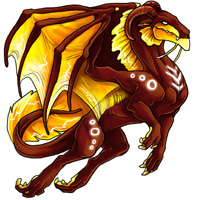Pet Facts



Belragoth Facts
|
Belragothes are extremely muscular, enabling them to take off vertically; they can also land the same way.
|
|
Belragothes have developed the ability to take off vertically because of their habitat; they like to live in seclusion on high mountaintops that often times don't have enough flat ground for a running start. They use their muscular bodies to jump high enough to clear the jagged rocks and spread their wings.
|
|
Belragothes love to fly, and can remain in the air for hours on end.
|
|
Their homes and feeding grounds are usually not close to each other. Belragothes have flight paths they follow as a routine, and many flight paths lead to feeding grounds, mating grounds, even battlegrounds where Belragothes battle each other to show off their strength.
|
|
Belragothes live in seclusion, and it's rare to see Belragothes in large groups or even pairs. On the rare occasion that multiple Belragothes gather in one place, the group is called a Drive.
|
|
Belragothes will sometimes pair up with siblings while they are young and will part ways when older.
|
|
Belragoth males usually live alone in the high mountains. They sleep a lot more then females, but they eat just as much.
|
|
Belragoth females usually lay about 1-3 eggs in a clutch, although it is most common for a female to lay just one. She will take care of the egg on her own in a special nest crafted from 'heat stones' in her cave. These stones never cool down, remaining warm even when the temperature outside begins to plummet below freezing. Belragoth females use these rocks to help hatch her eggs when she is out hunting for food, which she will stockpile for months to feed her newborn.
|
|
Belragothes can live for a very long time if conditions are right.
|
|
Belragothes and Braenon are natural enemies-- this is because Braenon Bouquets are often located in the way of Belragothes' flight paths. The reason why Bouquets are located within a flight path is unknown to researches, but it has been theorized that when a Belragoth flaps its wings, the wind around it creates a rare nutrient required for the growth of a berry that is a main source of food for Braenon.
|
|
Belragothes will attack Braenon for a source of food when given the opportunity, but it's no easy meal. Braenon are very quick and intelligent, while Belragothes are too bulky to compete with the Braenon's superior speed. Belragothes will simply terrorize Bouquets in hopes of scattering them to find any weak ones.
|
|
Belragoth mothers are extremely protective of their young, and will attack any intruder who gets too close to her children/eggs.
|
|
While Belragothes are born with fine, needle-like teeth, they are not strong enough to tear through the meat that they eat. Therefore, a mother Belragoth must chew the meat and regurgitate it for her young to eat until their teeth are strong enough for them to eat on their own.
|
|
Belragoth chicks spend much of their childhood mock-fighting with their mothers' tails, or, in the case of multiple siblings, each other.
|
|
Belragoth mothers will only produce another clutch of eggs once their current chick(s) have left the nest. Perhaps the fact that Belragoth chicks spend up to five years with their mother is why the species has such a low population.
|
|
It is not uncommon to see Belragothes with broken horns, for headbutting is one of the ways that they compete for resources such as food and shelter.
|
|
Belragothes are solely carnivores; save for a select few medicinal herbs, most plants (including fruits and vegetables) can make a Belragoth very sick if ingested.
|
|
Because of how scarce food can be, Belragothes never let any part of a meal go to waste -- their stomach acid is strong enough to digest even bone.
|
|
Belragothes have extremely developed senses of smell, which help track down prey from long distances. They also have amazing eyesight so that they can easily spot their next meal from high up in the air.
|
|
Belragothes prefer to hunt from the sky. They dive-bomb their prey, sometimes reaching speeds of over 100 mph, and the impact of their bodies is usually enough to stun or knock-out their target.
|
|
When young, a Belragoth's wing membranes are very fragile and easily torn. However, they will strengthen and become much more durable and flexible as the Belragoth ages.
|
Go Back
